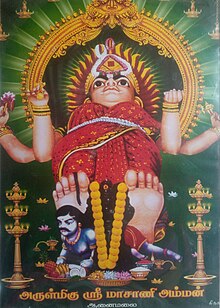Masani Amman
| Arulmigu Sri Masani Amman Temple | |
|---|---|
அருள்மிகு ஸ்ரீ மாசாணியம்மன் திருக்கோயில் | |
 Poster depicting the main idol of Masani Amman | |
| Religion | |
| Affiliation | Hinduism |
| District | Coimbatore |
| Deity | Masani Amman (Shakti) |
| Festivals | Navaratri,Vijaya Dashami |
| Location | |
| Location | Anaimalai |
| State | Tamil Nadu |
| Country | |
| Geographic coordinates | 10°34′32″N76°56′05″E/ 10.5755701°N 76.9348486°E |
| Architecture | |
| Type | Dravidian architecture |
| Completed | before 1000 CE[1] |
| Website | |
| Official Website | |
Masani Ammanis aHindudeity. She is primarily worshipped as a family deity (kuladevi) by certain classes inTamil Nadu,where she is regarded as anavatar(incarnation) ofAdi Parashakti.[2]Her chief temple is located inAnaimalai,Pollachiarea,Coimbatore districtofTamil Nadustate,India.[3][4]
Arulmigu Sri Masani Amman Templeis a highly revered shrine situated in Anaimalai, which is located about 24 km (15 mi) southwest of Pollachi. At the confluence of theAliyar Riverand the Uppar stream, the temple is built on grassland near the Anaimalai Hills and enshrines the sleeping goddess Masani Amman as the presiding deity. She is seen in a unique lying posture, measuring 15 ft (4.6 m) from head to foot. In her four hands she holds adamaruwith a snake entwined around it, a fire bowl, a bowl containingkumkuma,and atrident.[5]Other deities worshipped in the complex includeneethi kall(stone of justice) and Mahamuniappan. It is a popular belief that Masani Amman cures any illness if one walks around her trident, which is located in front of the main sanctum.[1][6]She also provides relief from menstrual cramps.[1]



Legend
[edit]According to local tradition, during ancient times, Anaimalai was known as Nannur and the region was ruled by Nannuran, a wicked king who persecuted his subjects. He protected the fruits of his mango grove by instituting severe punishments for any who ate of them. One day, a woman unfamiliar with these measures ate one of Nannuran's mangoes, so he sentenced her to death. Despite public outcry against it, the woman was executed, and later Nannuran was killed by the villagers in a battle nearVijayamangalam.People believed that the woman had saved their lives by sacrificing herself and the people built a shrine to the executed woman and deified her. The stone where she was executed was later worshipped with ground red chillies as an offering. Its deity was originally called either "Masani" (meaning "mango" in old Tamil)[citation needed]or "Smashani" (Sanskritfor "graveyard", about the woman's untimely end),[5]depending on the version of the legend. Later, the deity came to be known as Masani Amman.[5]Masani Amman was later syncretised with the goddessAdi Parashakti.She was later associated with the goddessesMariamman,Angala Devi,IsakkiandKarumari.
See also
[edit]References
[edit]- ^abc"Sri Masaniamman temple".National Tamil Deity Temples.Dinamalar.
- ^Singh, Nagendra Kr (2006).Global Encyclopaedia of the South Indian Dalit's Ethnography.Vol. 2. Global Vision Publishing House. p. 180.ISBN978-81-8220-167-5.
- ^"Masani Amman temple".kovaizone.in. Archived fromthe originalon 29 January 2020.
- ^"Masaniamman Temple".tripadvisor.in.
- ^abc"Grind Chillies at Masani Amman Temple and Get Your Wishes Granted!".nativeplanet.com. 5 August 2016.
- ^Subramanian K R (29 August 2015)."மிளகாய் அரைத்து பூசினால்... நீதி வழங்கும் மாசாணியம்மன்"(in Tamil). oneindia.com.
External links
[edit]- Official Website
- Arulmigu Masani Amman Temple, Pollachi
- Temple of Justice in Tamil Nadu
- Shrine as a grievance cell[dead link]

